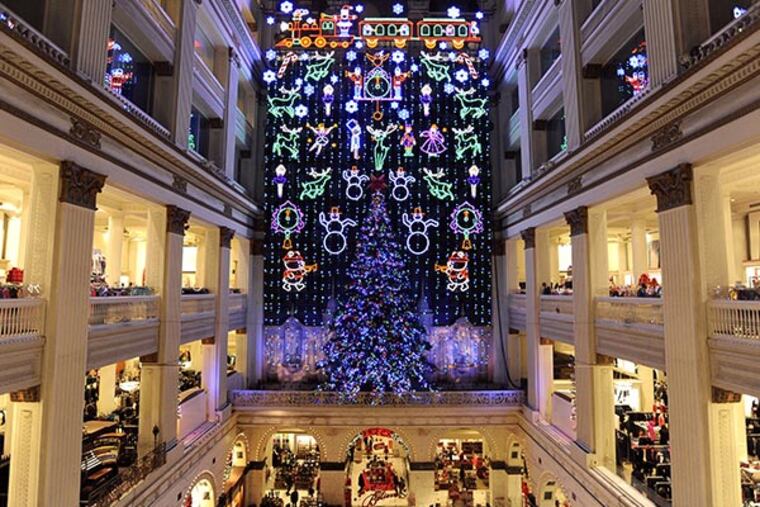It's Personal: How Lundgren led Macy in bouncing back
As backdrop to the legendary parade, the Macy's store at New York City's Herald Square is a star of the show on Thanksgiving. But ask Terry J. Lundgren about Philadelphia, and the Macy's CEO shares a surprising adoration for a different landmark altogether - the one in Center City that opened a century ago as Wanamakers.

As backdrop to the legendary parade, the Macy's store at New York City's Herald Square is a star of the show on Thanksgiving. But ask Terry J. Lundgren about Philadelphia, and the Macy's CEO shares a surprising adoration for a different landmark altogether - the one in Center City that opened a century ago as Wanamakers.
"That is one of the most unique stores in the entire enterprise of Macy's Inc.," the chairman, president, and chief executive said as he gushed, largely unprompted, about the Philly stunner that is home to the world's largest working pipe organ, the kitschy-but-adored Christmas Light Show, and the Dickens Village exhibit.
"It's the only store in the world that has a pipe organ and that has performances on this organ every single week - and we maintain that. I mean, who would do that?"
Here's who: A $28 billion company that believes, even amid the growing popularity of Internet shopping, that retailing remains a local game. With this guiding principle and Lundgren's charisma as change agents, the 800-store chain, now based in Cincinnati, has grabbed a top position only a few years after the department-store sector looked like an endangered species.
"We've grown by $5 billion in the last four years basically on just comparable-store sales growth," he said, citing a key indicator to underscore that feat.
A few weeks ago, Macy's posted more high profits off that same metric - sales growth at stores open at least a year. And not to be outmaneuvered, in 2012 the company opened a $150 million, 1.3 million-square-foot warehouse in West Virginia to fill Web orders quickly.
It's remarkable, considering the challenge Macy's faced after a cascade of mergers, acquisitions, and consolidation when the company absorbed many of the nation's teetering regional department-store chains.
Assembling such a patchwork of divergent systems and cultures might have sent a different company into the red. Instead, Lundgren has streamlined and spun those assets into gold.
"Luck favors the prepared mind. And Terry Lundgren was enormously well prepared for the position that he's in, to lead a consolidation of the department-store industry in the United States," said Richard Jaffe, an analyst with Stifel Nicolaus.
"To consolidate 82 different department-store brands under the Macy's marquee, and use that to create all kinds of economies of scale and efficiencies but also recognize a need to be local, to focus on the qualities which made those local players, in their early days, very successful," Jaffe said, is an achievement.
The Center City Macy's, once the flagship of the John Wanamaker chain, captures this. Its Dickens Village had been a feature of Strawbridge & Clothier, another now-defunct local chain.
Lundgren inherited a bureaucracy of merchandise buyers so unwieldy it was no longer in touch with local shoppers' desires.
"I had eight buying offices . . . a complete 1,500-person buying office: buyers, presidents, CFOs, heads of marketing, heads of public relations," he said Nov. 19 at a Wharton School gala. "I had every job duplicated eight times in eight cities around the country."
Today, "instead of having eight big, lumbering offices, we now have 60-plus offices of 20 people that only supervise between 12 and 15 stores. They know the customers."
If a store in Harrisburg serves shoppers who buy larger women's sizes, it will stock more of them than the King of Prussia store might. Many chains avoid such localization, for fear it costs more than it's worth.
But Macy's has become the largest retailer for many brands it sells. In return, vendors will send the stock, and sizes, it needs for each store, and be kind about it: "We're the largest customer of Ralph Lauren, of Michael Kors, of Calvin Klein. We're the only seller of Tommy Hilfiger. As a result of that, they do special things for us."
Analyst Dana Telsey said Lundgren's personality has been key to winning over employees and partners while restructuring.
"He comes up with innovative ideas," said Telsey, of Telsey Advisory Group. "He's able to collaborate with vendors, with employees, with associates, to engage every part of his organization."